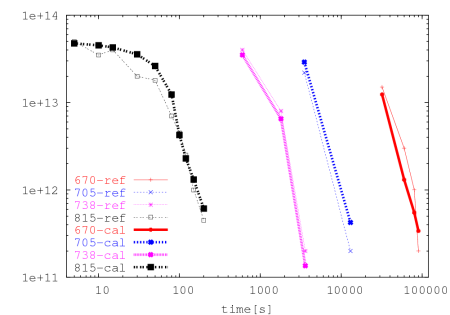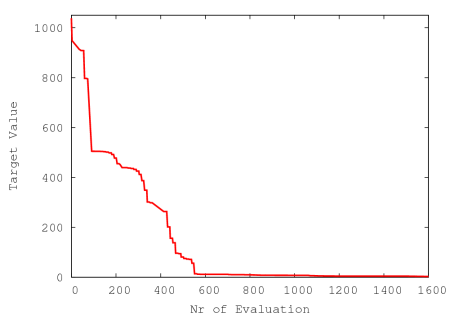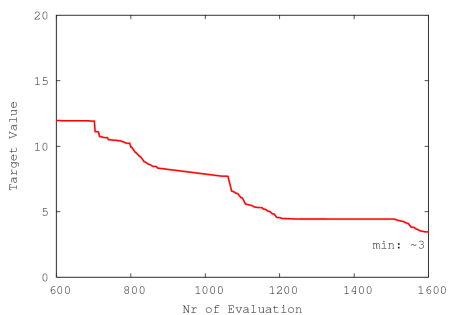The calibration of the TSUPREM-IV parameters as described above was performed with
the combination of the simulated annealing and the gradient based optimization
algorithm. Note that two measured points were ignored in this experiment since
their given concentration is above the implanted dose.
Table 5.1 depicts all parameters that were optimized during the
calibration task.
To account for the range of  decades of the dopant concentration and
under the assumption that all computed concentrations assume positive values
decades of the dopant concentration and
under the assumption that all computed concentrations assume positive values  the following scale function
the following scale function  was used to compute a deviation of a
computed from a measured point:
was used to compute a deviation of a
computed from a measured point:
![$\displaystyle S(p_m,p_c) = 100.0\cdot\left(10^{\ensuremath{\left\vert\frac{\log...
...ensuremath{\max\left[\log_{10}p_m, \log_{10}p_c\right]}}\right\vert}} -1\right)$](img372.png) |
(5.22) |
where  denotes a measured concentration and
denotes a measured concentration and  denotes a computed one
(delivered by TSUPREM-IV). The error vector was then again computed according to
(5.2). The obtained (optimized) parameter values are shown in
Table 5.1.
denotes a computed one
(delivered by TSUPREM-IV). The error vector was then again computed according to
(5.2). The obtained (optimized) parameter values are shown in
Table 5.1.
Figure 5.28:
Deviation
of measured and computed cluster concentration (with the calibrated
model). The reference dopings are drawn in thin
lines.
 |
Fig. 5.28 depicts the resulting deviation of computed from
measured dopings for the model parameters given in column "optimum" of
Table 5.1.
Fig. 5.29 and Fig. 5.30 depict the progress of the
combined (simulated annealing and local) optimizer. The optimization started
with a target value of
 . The best target of
. The best target of  was
reached after
was
reached after
 evaluations. The optimization was stopped after a
total of
evaluations. The optimization was stopped after a
total of  evaluations. No improvement in the target value was found for
evaluation numbers
evaluations. No improvement in the target value was found for
evaluation numbers
 .
.
Figure 5.29:
Progress of combined optimizer. The
plot shows the first  evaluations. The optimizer started at a target
value of
evaluations. The optimizer started at a target
value of
 .
.
 |
Figure 5.30:
This plot depicts a detailed view of
Fig. 5.29. Evaluation numbers
 are shown. The final
optimum of
are shown. The final
optimum of  was reached after
was reached after  evaluation. No further improvement
was found within another
evaluation. No further improvement
was found within another  evaluations.
evaluations.
 |
2003-03-27


